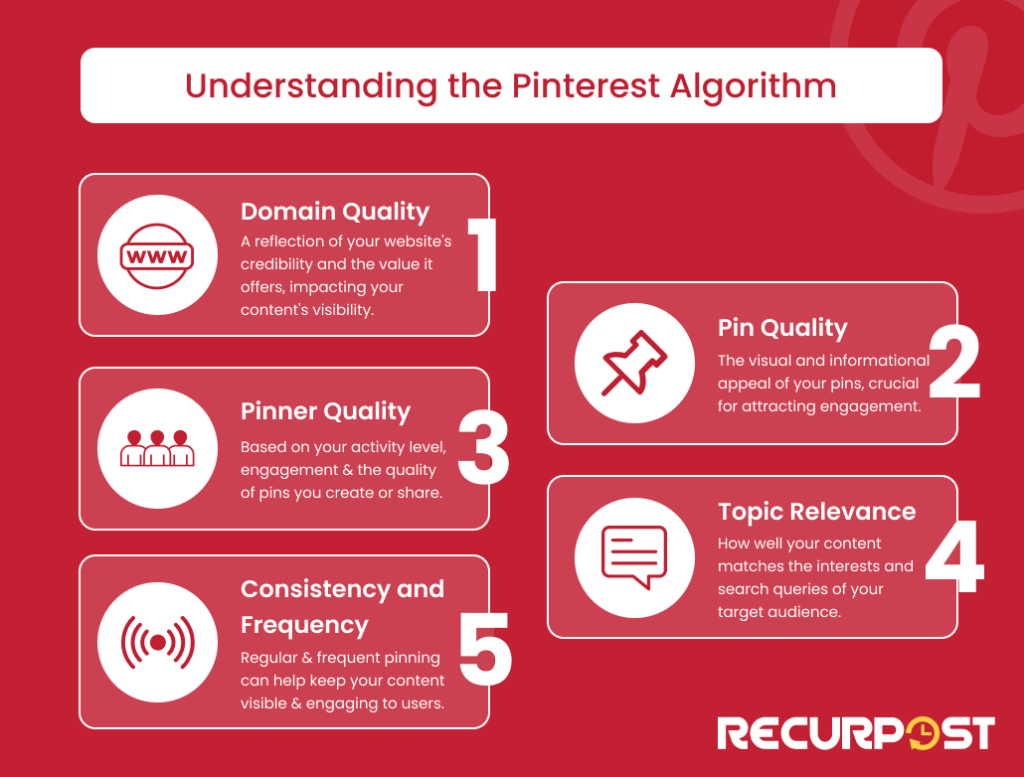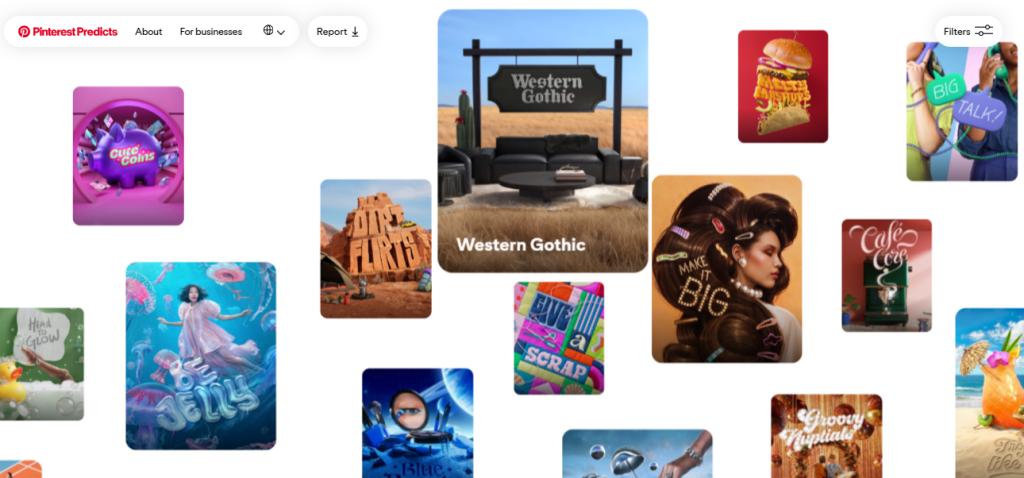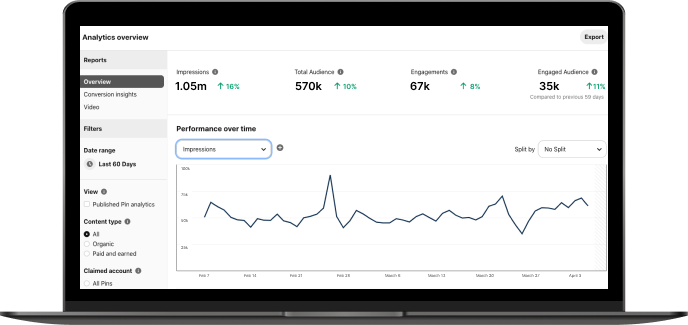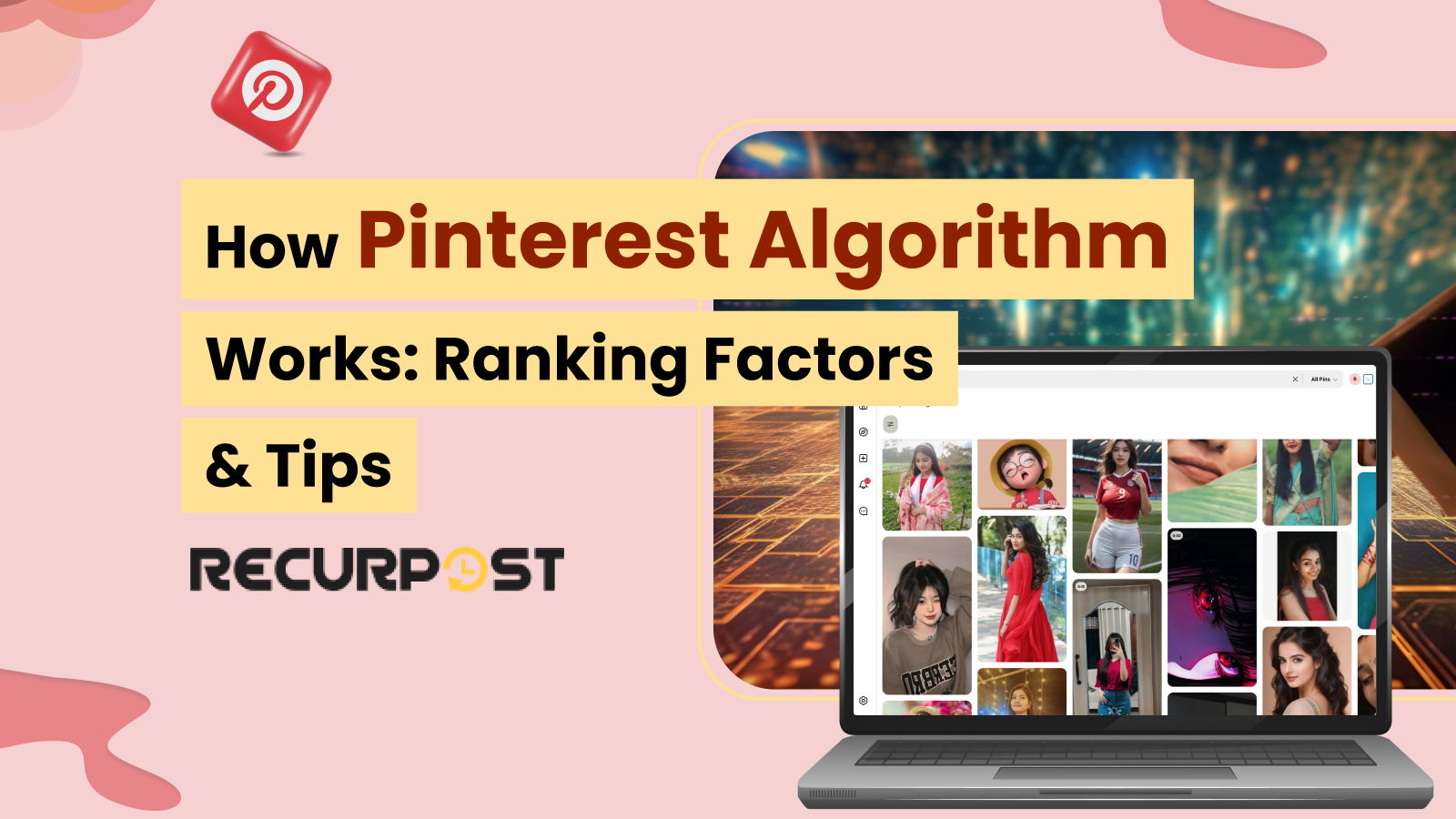Pinterest functions as a visual discovery engine, bridging creativity and discovery, similar to a notice board where users display ideas about food, fashion, handicrafts, real estate, and other topics.
With millions of ideas competing for attention, the Pinterest algorithm acts as a smart organizer, determining which pins appear for each user based on specific ranking factors.
The more you understand how the Pinterest algorithm works, the higher the chance that the correct audience will see your pins. People may pay more attention to your site, they may be interested in your products, and even your sales may grow!
Understanding Pinterest’s algorithm helps ensure your pins catch people’s attention.
Does Pinterest have an Algorithm?
Pinterest employs three main algorithms working behind the scenes to personalize user experiences and content discovery:
1. Pinterest Home Feed Algorithm
The Home Feed algorithm decides what Pins you see when you open the app or website. It looks at what you’ve liked, saved, or clicked on before. Then, it shows content you’re likely to enjoy based on your previous interactions. This algorithm also considers what’s popular right now and what’s new on Pinterest.
2. Pinterest Search Algorithm
When you search for something on Pinterest, the Pinterest search algorithm goes to work by processing your query through natural language processing and visual recognition technology that matches your search terms with pin descriptions, board titles, and image content to deliver the most relevant results.
3. Pinterest Ads Algorithm
This algorithm is all about showing you ads that you might actually like. It looks at your interests, what you’ve searched for, and the kinds of Pins you usually interact with. Then, it matches you with ads from businesses that fit those interests. The goal is to show you ads that are helpful and interesting to you.
How Does the Pinterest Algorithm Work?
Understanding how the Pinterest algorithm will work in 2025 begins with knowing how the algorithm works mechanically by processing millions of data points through machine learning models that analyze user interactions, content freshness, domain authority, and engagement rates to prioritize content for personalized recommendations.
Pinterest uses these factors as quality signals to evaluate pins and boards for recommendation purposes.

1. Domain Quality: Your Website’s Reputation
Domain quality ranks as a critical factor – Pinterest evaluates whether your website maintains verification status, contains backlinks from trusted sites demonstrating value, and offers mobile responsiveness.

How to Improve: Verify your website with Pinterest to prove ownership. Remember, creating good, trustworthy links is one of the best SEO techniques for getting your niche-specific website to be recognized by other respected websites. Make sure your website has a responsive design for convenient browsing on smartphones and tablets.
2. Pin Quality: Make it Attractive!
The better and more appealing your pin is visually, the more people will click it. Use images that grab attention, write descriptions that will spark curiosity, and be sure to provide content that matches your audience on Pinterest.

How to Improve: Make sure to use high-quality photos or well-designed graphics. Optimize your images’ aspect ratios for Pinterest. Craft compelling descriptions using relevant keywords that accurately describe your products or content.
3. Pinner Quality: Are You a Pinterest Pro?
Being active on Pinterest shows the algorithm you’re serious about. Pin regularly, build up your followers, and chat with people in the comments to show you care about the community.

How to Improve: Create and share valuable pins consistently. Engage with your audience and other users by liking, commenting, and replying to their posts. Engage in group boards around your niche.
4. Topic Relevance: What’s It All About?
Pinterest uses your description tag to determine relevancy, figuring out what your pin is about and showing it to the right people. If your pin is about baking cookies, make sure the description and keywords say that clearly!

How to Improve: Conduct keyword research to find what people are searching for on Pinterest. Use these keywords naturally in your pin descriptions, titles, and board names.
5. Consistency and Frequency: Keep it Fresh!
Regularly sharing new pins signals that you’ve got great content to offer. Pinterest loves fresh ideas, so keep the amazing pins coming!

How to Improve: Use a Pinterest Scheduler to develop a regular pinning schedule and stick to it. Create multiple fresh, new pins each week. Don’t just repin old content – focus on offering new ideas and perspectives.
Key Factors Influencing the Algorithm
While the factors we discussed earlier lay the foundation for a strong Pinterest presence, several additional elements can significantly influence how the algorithm perceives and ranks your content for users. Let’s explore these key factors in more detail:
1. User Engagement: Do People Love It?
When people save your pins, click through to your website, view close-ups, or leave comments, it shows Pinterest that your content is worth highlighting.
2. Keyword Optimization: Speaking of Pinterest’s Language
Like Google, Pinterest has its own search engine. Do some keyword research to see what words people are already using when searching for something like your topic. Then, naturally, include those keywords in your pin descriptions, titles, and board names.
3. Freshness of Content: New is Always Better
Pinterest loves seeing new activities. Create and share fresh pins regularly to show the algorithm that you’re an active content creator.
4. Social Signals: Popularity Matters
Getting repins, comments, and attracting new followers all indicate that people find your content valuable. Focus on creating share-worthy pins, and engage with your community to boost social signals. [Learn how to get more Pinterest followers].
Rich Pins & Pinterest Features: Unlock Extra Power
Rich pins give more information about a product rather than a regular one, for example, the price or ingredients of a recipe. Furthermore, Pinterest is constantly rolling out new features, including Story Pins and Idea Pins. Try these formats to make your content more visible.
The topmost priority of Pinterest’s algorithm design is to precisely identify and optimize these key factors so that everything you post reaches the right audience at the right time.
Useful Strategies for Overcoming the Pinterest Algorithm
With this understanding of Pinterest algorithms, you can now implement effective strategies. Here are some practical tips to optimize your Pinterest strategy:
1. Optimize for SEO: Think Like a Search Engine
Conduct keyword research using tools like Pinterest Trends or traditional keyword planners. Include relevant keywords in your pin titles, descriptions, board names, and even your profile bio.
2. Create High-Quality Visuals: Stand Out from the Crowd
Use clear, well-lit images or attention-grabbing graphics. Optimize your pin’s dimensions. Pinterest recommends a 2:3 aspect ratio. Ensure your pins are attractive and informative.
3. Engage with the Community: Be a Good Pinterest Citizen
Follow other accounts with similar interests. Join relevant group boards. Participate in discussions on other people’s pins. Consider hosting contests or giveaways to boost interaction.
4. Use Pinterest Analytics: Data is Your Friend
Pinterest’s built-in analytics will reveal the most popular pins and will even present you with insights on your audience. Use this data to adjust your content strategy and find what works best for you.
5. Leverage Pinterest Features: Embrace the New
Rich Pins provide extra details (product prices, recipes, etc.). Story Pins offer a multi-image format, and Idea Pins are great for tutorials and step-by-step content. Use these to boost engagement.
6. Schedule Pins: Consistency is Key
Pinterest scheduling tool helps you maintain a regular pinning schedule. Consistency sends Pinterest a message that you are indeed a reliable and persistent content provider.
If you have any queries on scheduling pins, please refer to our blog, which will help you understand how to schedule pins on Pinterest.
Related: How to pin on Pinterest.
7. Create Fresh Content: Feed the Algorithm
Regularly introduce new pins. Keep your content timely by aligning with current trends or seasonal events.
8. Focus on User Experience: Put People First
Ensure your website is mobile-ready and responsive. If a visitor clicks your pin, the site should load quickly and be easy to navigate, offering helpful content.
9. Pinterest Search Ranking Tactics: Climb Higher in Results
To rank higher on Pinterest search results, focus on these targeted ranking methods.
- Optimize your pin titles with primary keywords at the beginning, since Pinterest weighs early keywords more heavily in search rankings.
- Create multiple pins for the same content with different keyword variations to capture broader search traffic and increase your chances of ranking for related terms.
- Pin your content to relevant group boards with high engagement rates to boost initial visibility signals that Pinterest uses for ranking.
- Time your pins during peak activity hours when your target audience is most active on Pinterest to maximize early engagement.
- Build topic authority by consistently creating content within specific niches, which signals Pinterest that you’re a reliable source for those subjects and improves your overall ranking potential.
These strategies will improve your content’s visibility and engagement through Pinterest’s algorithm.
New to Pinterest and want to start using Pinterest for marketing? Check out this guide on how to use Pinterest to get started!
How to Reset the Pinterest Algorithm?
If you want to reset the Pinterest algorithm to refresh your feed and retrain the Pinterest algorithm’s personalization system to show different content recommendations, follow these steps:
1. Clear Search History: Go to your settings and clear your recent searches to remove past influences.
2. Engage with New Content: Start searching for and saving pins in new categories and interests to guide the algorithm.
3. Update Boards: Create new boards and add pins that align with your current interests.
4. Unfollow Irrelevant Boards: Stop following boards that no longer interest you to help refocus your feed.
5. Tune Your Home Feed: Next to your profile picture in the top-right corner, click the down arrow and select ‘Tune your Home Feed‘. Follow the instructions to gradually change your feed to better match your interests. This process specifically resets your Pinterest feed algorithm by clearing previous engagement patterns and allowing you to retrain the system with fresh preferences. Regularly tuning your feed helps maintain relevant content.
6. Edit Personalization Settings: Adjust your personalization settings to refine your Pinterest experience. For more details, visit Edit Personalization Settings.
7. Reset Feed Preferences: Access your account settings and look for “Home feed preferences” or “Feed settings” to manually reset your feed algorithm. This action clears your existing feed personalization data and allows Pinterest to rebuild your feed recommendations from scratch based on new interactions and saved pins.
These actions will help Pinterest understand your new preferences and show you more relevant content.
Community Guidelines: Using Pinterest Responsibly
Pinterest has clear rules to maintain a fair and enjoyable experience for everyone. Here are some important guidelines:
- Avoid manipulating Pinterest algorithms or user traffic. This includes using fake accounts to boost your affiliate links or asking others to save or create Pins with your affiliate identifiers.
- Do not create repetitive or large volumes of affiliate Pins. Marketers should follow Pinterest’s spam policy and use affiliate links sparingly.
- Pinterest may remove, limit, or block content or accounts that violate these guidelines to ensure a healthy community environment.
For detailed guidelines, please visit Pinterest Community Guidelines.
Is the Pinterest Algorithm Broken?
Many users claim the Pinterest algorithm is broken, citing a decrease in visibility for pins and inconsistent traffic. However, the Pinterest algorithm is not broken but rather continuously evolving through regular updates, where these issues often stem from changes in how content is ranked or optimized rather than actual system malfunctions.
If the Pinterest algorithm seems broken, it’s worth reviewing your content strategy to ensure your pins are aligned with current trends and SEO best practices.
Adapting to Algorithm Changes
Pinterest algorithm changes occur frequently, making it one of the various social media platforms that continuously evolve their ranking systems. The latest Pinterest algorithm updates in July 2025 and August 2025 introduced refined ranking mechanisms that prioritize authentic content creation and user engagement quality metrics over traditional quantity-based performance indicators.
To remain in the top position, staying informed about these algorithm updates and adjusting your strategies accordingly becomes vital for maintaining pin visibility.

Strategies for Staying Updated
- Follow Industry Blogs: Many blogs specialize in Pinterest marketing and social media news. These resources often share insights into the latest algorithm changes.
- Join Groups: Facebook groups and Pinterest marketing forums are good resources for asking questions, sharing tips, and getting information about what is working for others.
- Webinars & Conferences: Attend virtual webinars and industry conferences where experts from the Pinterest community discuss the latest algorithm trends and best practices.
Recent Algorithm Updates in 2025
Pinterest has rolled out several algorithm updates throughout 2025, with notable changes in July and August that have refined how the platform evaluates content quality and user engagement patterns. These updates have modified pin performance metrics and ranking signals, requiring content creators to adapt their pinning strategies and keyword optimization approaches.
Monitor your Pinterest Analytics closely during algorithm update periods to track performance shifts and modify your content strategy based on the new ranking factors introduced in these updates.
Importance of Reviewing & Adjusting
Don’t set your Pinterest strategy on autopilot. Review Pinterest analytics regularly to monitor performance changes. If your engagement dips after an algorithm update, it might be time to adjust your keyword strategy, pinning frequency, or type of content you share.
The Pinterest algorithm has been developed to improve the user experience on the platform. When you keep the quality of your content as the first prerogative, you are still in the game – even if the algorithm gets changed.
Conclusion
Understanding how the Pinterest algorithm works for business is the key to reaching the right audience and boosting your results. By focusing on quality content, optimizing for search, engaging with your community, and making use of Pinterest’s features, you can expect the following benefits:
- Get Seen: Increase visibility and reach more people.
- Spark Interest: Drive engagement with saves, clicks, and repins.
- Boost Traffic: Send more potential customers to your website.
- Grow Sales: Convert Pinterest inspiration into sales.
Remember, the algorithm constantly evolves. Stay updated on trends and create quality content that resonates with your audience.
This strategy is just one factor influencing Pinterest’s algorithm. To take a closer look at social media algorithms, explore our guide: Social Media Algorithms Explained.
Moreover, understanding the Pinterest algorithm is key to getting your content seen by the right audience. If you want to turn that visibility into real results, check out how to get traffic on Pinterest and start driving more visitors to your site.
FAQs on Pinterest Algorithm
1. What is the ideal frequency for pinning on Pinterest?
Set up a target of pinning multiple times each day; nevertheless, concentrate on creating high-quality pins. Tools like RecurPost can help you post on Pinterest at the best times.
2. Why are Rich Pins important, and how can I use them effectively?
Rich Pins provide more information directly on the pin. Product Pins show pricing and availability, Recipe Pins show ingredients and cooking times, and Article Pins display the headline. To enable Rich Pins, apply on Pinterest’s website and validate your website’s code. If you’re planning to use Pinterest for blogging, Rich Pins can be especially helpful for sharing article content in a more engaging way.
3. Why is the Pinterest algorithm so bad?
Many perceive the algorithm in social media, especially on Pinterest, as flawed due to unpredictable changes in pin performance and search visibility. However, these changes are often tied to updates aimed at improving user experience. To work around these issues, focus on creating evergreen content and analyzing performance metrics regularly.
4. My pins aren’t getting seen. What am I doing wrong?
Make sure the keywords you are using are relevant and the ones that people use to search. Ensure that your pins look attractive with high-quality images and explanatory captions. Lastly, be sure that your site can be viewed easily on mobile devices; otherwise, by not having a strong mobile experience, your rankings on Pinterest can decrease. Also, avoid cluttering your profile. If a board is no longer useful or aligned with your goals, it’s better to delete a board on Pinterest to keep your content organized and focused.
5. How can I keep up with the constant algorithm changes?
The easy way is to stay connected with the Pinterest marketing community. Subscribe to blogs that are focused on Pinterest and join the relevant Facebook groups. Look for webinars and events organized by experts on Pinterest, where they discuss the algorithm updates and the best practices.
6. I’m using all the right keywords, but my engagement is low. Why?
Even with the right keywords, ask yourself if your content is genuinely valuable to your target audience. Are you solving their problems or providing real inspiration? Also, be an active community member. Like, comment, and repin content from others.
7. Where do I even find the keywords people are searching for on Pinterest?
Pinterest has its own tool called Pinterest Trends. That shows you popular search terms. Watch for suggestions that pop up as you type in Pinterest’s search bar. You can even use traditional keyword research tools for additional insights.
8. How to change the Pinterest algorithm?
While users cannot directly change the Pinterest algorithm, they can adapt to its updates by optimizing their content. Focus on using relevant keywords, quality visuals, and consistent pinning strategies to influence how your content is prioritized.

Saurabh Chaturvedi is a content writer at RecurPost. Specializing in social media management and marketing, Saurabh is dedicated to crafting engaging and informative articles. His passion for clear, exciting content keeps readers eager for more.





